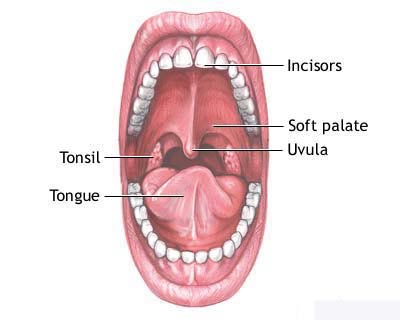|
Examining your mouth
You are at a
higher risk for developing oral cancer if:
- you use tobacco products
- drink excessive amounts
of alcohol
- exposed to sunlight on a
regular basis
- have habits such as lip
biting and cheek chewing
- have ill-fitting
dentures
It is important to learn how to
examine yourself for signs of oral cancer and to have regular check-ups in order
to increase the chances of discovering the condition in the early stages before
it progresses. Some early warning signs of oral cancer are:
- any sores on the face,
neck, or mouth that do not heal within two weeks
- swellings, lumps or
bumps on the lips, gums or other areas inside the mouth
- white, red, or dark
patches in the mouth
- repeated bleeding in the
mouth
- numbness, loss of
feeling, or pain in any area of the face, mouth or neck
To perform the oral cancer self
examination, just follow these 7 easy steps.
Look at and feel your:
◊
Head and Neck
- look at your face and
neck in a mirror. Normally, the left and right sides of the face have the
same shape. Look for any lumps, bumps, or swellings that are only on one
side of your face
◊
Face
- examine the skin on your
face. Do you notice any colour or size changes, sores, moles, or growths?
◊
Neck
- press along the sides
and front of the neck. Do you feel any tenderness or lumps?
◊
Lips
- pull your lower lip down
and look inside for any sores or colour changes. Next, use your thumb and
forefinger to feel the lip for lumps, bumps, or changes in texture. Repeat
this on your upper lip
◊
Cheek
- use your fingers to pull
out your cheek so you can see inside. look for red, white, or dark
patches. Put your index finger on the inside of your cheek and your thumb
on the outside. Gently squeeze and roll your cheek between your fingers to
check for any lumps or areas of tenderness. Repeat this on the other cheek
◊
Roof of the Mouth
- tilt your head back and
open your mouth wide to see it there are any lumps or if the colour is
different than usual. Run your finger on the roof to feel for lumps
◊
Floor of the Mouth and
Tongue
- Stick out your tongue
and look at the top surface for colour and texture. Gently pull your
tongue forward to look at one side first and then the other. Look for any
swellings or colour changes. Examine the underside of your tongue by
placing the tip of the tongue on the roof of your mouth.
Look at the floor of your mouth and the underside of your tongue for
colour changes that are very different from what is normal. Gently press
your finger along the underside of your tongue to feel for any lumps or
swellings
If you find anything out of the
ordinary, particularly anything that does not heal or go away in two weeks, or
that has recently changed, discuss it with your oral health professional or
physician.
|